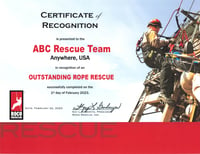Real Rescue: Dozer Driver Buried in Wood Chip Pile at Paper Mill
In the process of making paper, everything is big. From the logs that are cut from the dense forests of the south to the giant equipment used to push through huge piles of wood chips, the sheer size of the operation poses unique challenges for the crews working in this industry. For one southern rescue team in late 2022, those challenges would test both their training and their resolve.

December weather can be tricky in the south. Warm days followed by chilly nights can make conditions on the chip pile unpredictable. When the chip pile is 50 feet tall and hundreds of feet long, small changes in the moisture level and temperature of the wood chunks can have drastic results. On this night, the operator of a D9 Dozer was working the top of the pile moving chips towards the conveyor belt that pulls the chip into the feeder from the bottom of the pile. Changing conditions above the conveyor belt often result in small void spaces or bridges that are safely pushed back down by the weight of the dozer. The workhorse of moving dirt, the D9 is a spectacular piece of equipment. Thirteen feet tall, 27 feet long, and 54 tons of pure power, the D9 easily moves over the pile to keep chips moving into the plant.
Just before 8:00 PM, the dozer operator called the plant on his cell phone. While backing along the pile, the weight of the dozer collapsed a bridge under the pile. Not the common small bridge that wouldn’t even be noticed by the operator, this one was big, beyond the comprehension of even the longest-term employees. The bridge didn’t just collapse, it consumed the dozer.
When rescuers arrived, only the blade of the dozer was visible, and it was facing straight up toward the now-black night sky. The huge earth mover had fallen backward into the collapsing hole, the force of the impact shattering the rear window, slamming chips into the cab behind the operator. With a rapidly dying cell phone battery, the operator stated that he was trapped in complete darkness below more than 20 feet of wood chips.
 The rescue operation was led by a long-time member of the rescue team. Even when supervisors and safety managers arrived, the operation continued to be directed and led by that team member. The managers and safety department personnel seamlessly slipped into the roles of logistical support and safety officer. As more rescue team members arrived, the dig teams began the excavation.
The rescue operation was led by a long-time member of the rescue team. Even when supervisors and safety managers arrived, the operation continued to be directed and led by that team member. The managers and safety department personnel seamlessly slipped into the roles of logistical support and safety officer. As more rescue team members arrived, the dig teams began the excavation.
Over the next 3-1/2 hours, a dozen rescuers rotated through 20-30 minute shifts moving wood chips by hand. With a now-dead cell phone, the operator was able to update the team by radio. As the rescue operation moved deeper into the night, it became apparent that the dozer operator was weakening, leading the rescue team to believe that the oxygen in the cab was being consumed at a rate that was faster than the rescue excavation.
As the hole expanded, the team needed rope systems to support their climbs in and out of the hole in the pile. Another dozer was gingerly moved to the top of the pile to create a portable anchor for the rope systems. Rescuers struggled to contain the flowing wood chip that continuously rolled back into the hole. At one point hours into the rescue, a track hoe was brought next to the pile to move the edges away to reduce roll-in material, but the bulk of the work was done by hand.
With the operator weakening, rescuers finally made it to the cab near midnight, 3-1/2 hours into the operation. With the very real possibility of a secondary collapse when the cab door was opened, the rescue team was forced to make the decision whether to open the hole wider or move the rapidly deteriorating patient now. The decision was made to make the move. A SKED stretcher was moved into position and a 3:1 mechanical advantage was built and made ready to haul. The door was opened and rescuers made entry into the cab, quickly transferring the patient to the SKED who was then hauled up the slope of the excavation.
The dozer operator was transferred to EMS who transported him to a local hospital where he was treated for symptoms of heat stroke, dehydration, and mild hypoxia. He was treated and later released with no long-term issues. The safety manager credits the operator’s off-shore helicopter crash survival simulator training with keeping him calm and preserving the air supply in the cab.
Roco Rescue was honored to present this talented and dedicated rescue team with the Roco “Real Rescue” plaque. Their dogged determination and training resulted in a great outcome for a very lucky heavy equipment operator.
Roco Would Like to Recognize Your Outstanding Rope Rescue!
Nominate your rescue team for a free Roco Outstanding Rope Rescue Plaque. All reports that we receive highlighting an actual rescue event will be considered
Click here to download the Real Rescue Form. You can then email form to info@RocoRescue.com.





